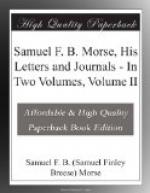“After stopping at the Hotel de Nouvelle Paros, which we found a miserable inn with bad wine, scanty fare and high charges, we took a hasty breakfast, and procuring a guide we walked out to see the curiosities of the place. It rained hard and the road was excessively bad, sometimes almost ankle-deep in mud. Notwithstanding the forbidding weather and bad road, we labored up the deep ravine on the sides of which the excavations are made. Dark peaks frowned above us capped with clouds and snow; white patches midway the sides showed the veins of the marble, and immense heaps of detritus, the accumulation of ages, mountains themselves, sloped down on each side like masses of piled ice to the very edge of the road. The road itself, white with the material of which it is made, was composed of loose pieces of the white marble of every size.... Continuing the ascent by the side of a milky stream, which rushed down its rocky bed, and which here and there was diverted off into aqueducts to the various mills, we were pointed to the top of a high hill by the roadside where was the entrance to a celebrated grotto, and at the base close by, a cavern protected a beautiful, clear, crystal fountain, which gushed from up the bottom forming a liquid, transparent floor, and then glided to mingle its pure, unsullied waters with the cloudy stream that rushed by it.
“Climbing over piles of rock like refined sugar and passing several wagons carrying heavy blocks down the road, we arrived at the mouth of the principal quarry where the purest statuary marble is obtained. I could not but think how many exquisite statues here lay entombed for ages, till genius, at various times, called them from their slumbers and bid them live....
“On our return we again passed the wagons laden with blocks, and mules with slabs on each side sometimes like the roof of a house over the mule.... The wagons and oxen deserve notice. The former are very badly constructed; they are strong, but the wheels are small, in diameter about two feet and but about three inches wide, so sharp that the roads must suffer from them. The oxen are small and, without exception, mouse-colored. The driver, and there is usually one to each pair, sits on the yoke between them, and, like the oarsman of a boat, with his back towards the point towards which he is going. Two huge blocks were chained upon one of these wagons, and behind, dragging upon the ground by a chain, was another. Three yoke of these small oxen, apparently without fatigue, drew the load thus constructed over this wretched road. An enterprising company of Americans or English, by the construction of a railroad, which is more practicable than a canal, but which latter might be constructed, would, I should think, give great activity to the operations here and make it very profitable to themselves.”




